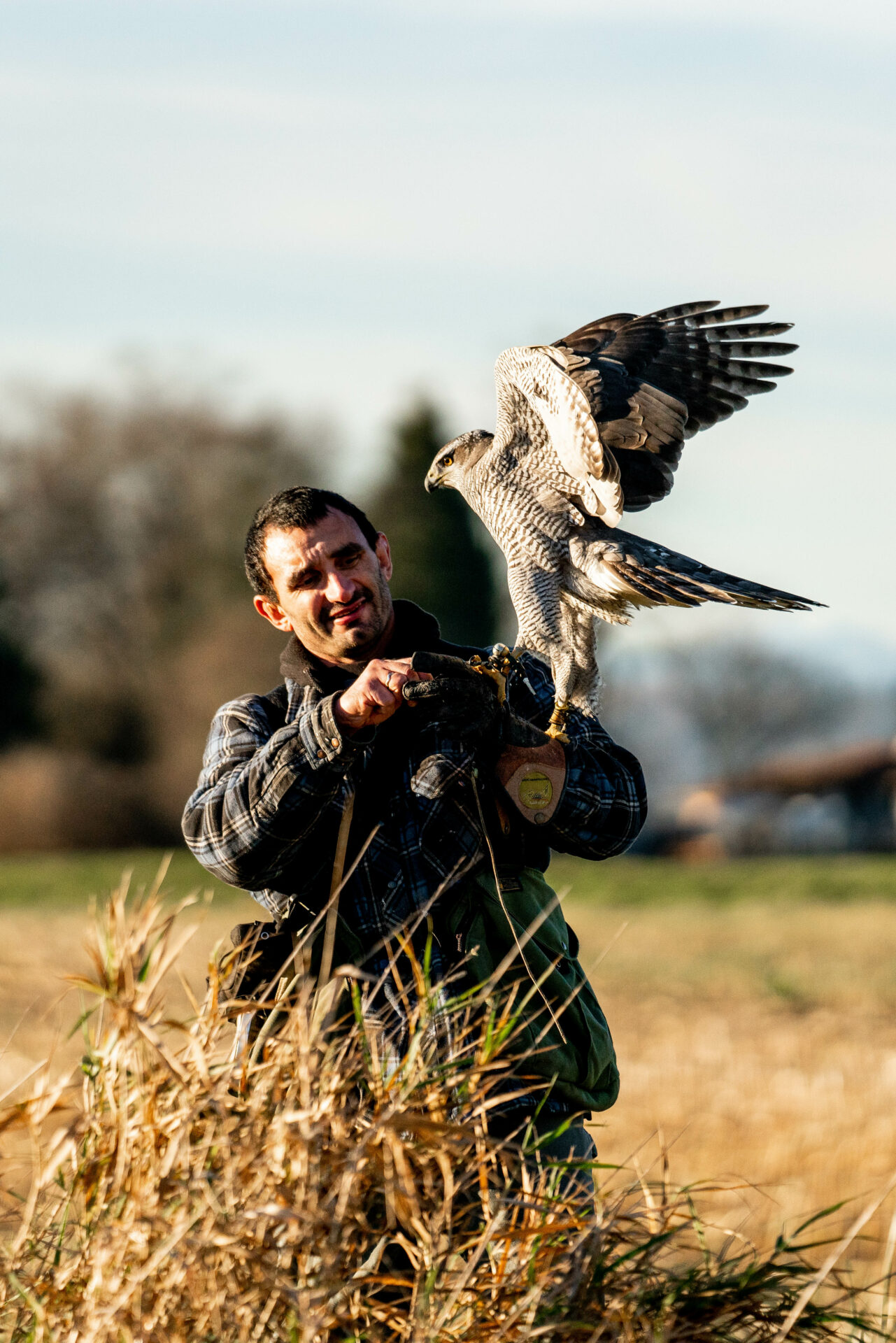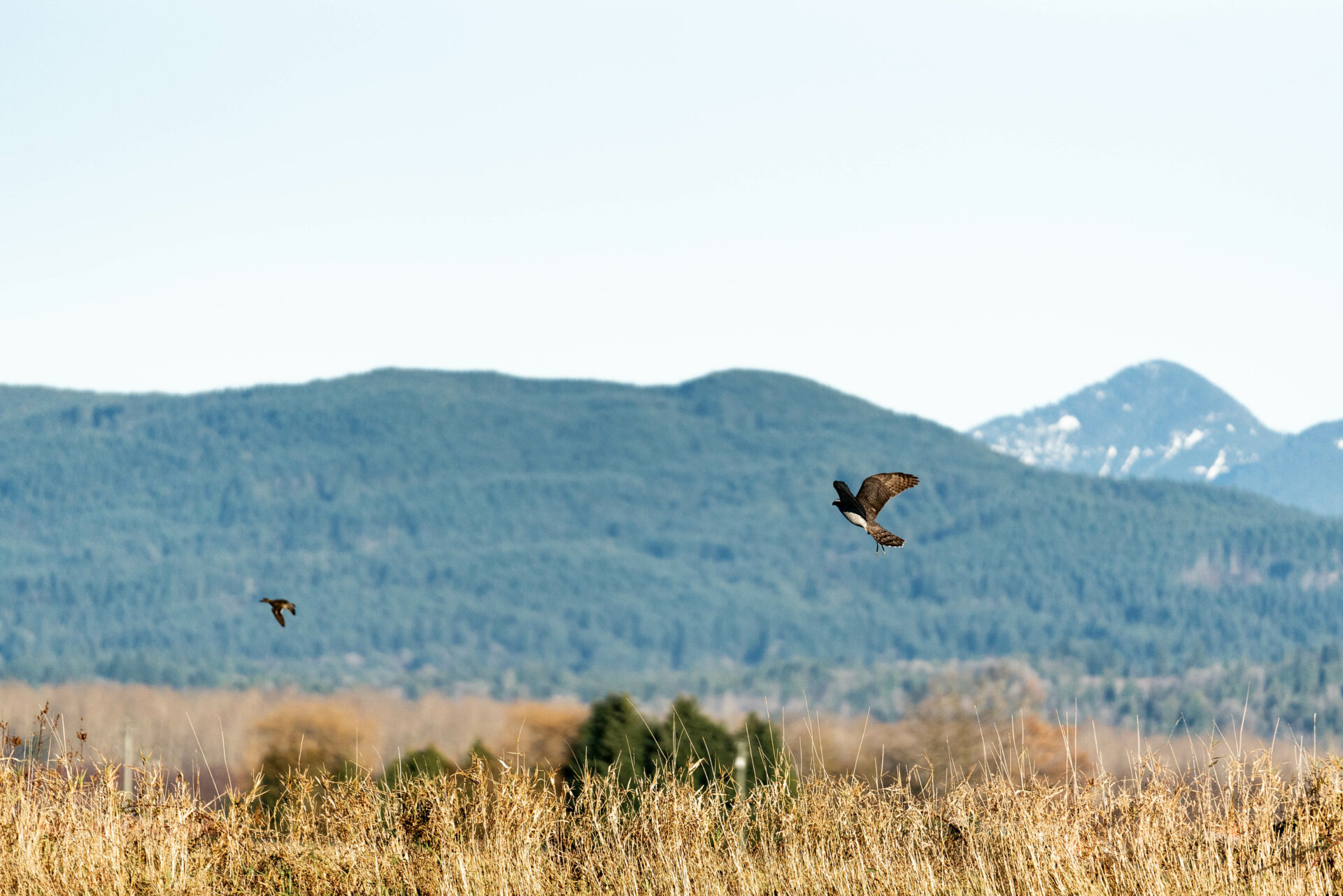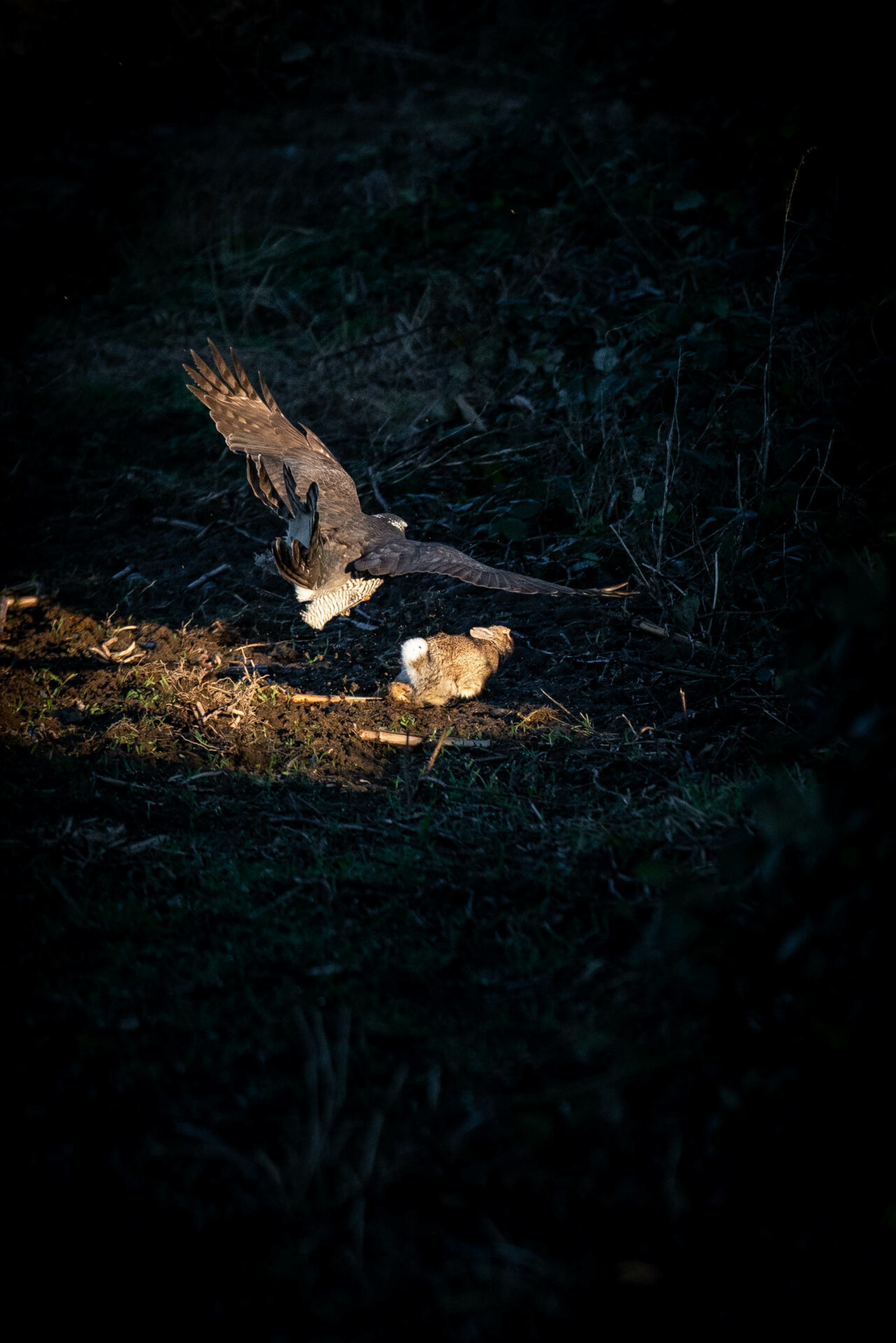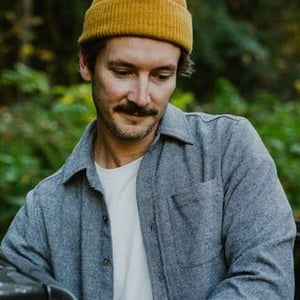Falcons are as hard to catch as a boy’s imagination. But Bob Smirfitt’s imagination, sparked by the story of a boy and his falcon, fanned into full flame when he was 16 years old when met a guy with a falcon on his arm at the BC Outdoorsmen’s Show. He began to imagine one day he would be a full-fledged falconer. This is the story of imagination taking flight.
Advertisement
The book, My Side of the Mountain, appealed to the boy Bob was. The book, written by Jean George, is about a New York City kid who runs away to the woods. He survives on wits and gumption, with the company of his pet peregrine falcon named Frightful. The boy feeds himself with prey the falcon collects when they hunt together.
Bob is now the president of the BC Hawking Club (bchawkingclub.ca), in addition to being an avid falconer.
Advertisement
Decision Time
Bob will tell you the decision to take on hawking is a serious one with serious consequences. Hawking or falconry is more than a sport or a lifestyle – it is a life. Once the raptor is acquired, your life revolves around the care and feeding, training and hunting of that bird. Being a falconer changes your life. Being a falconer is your life.
“While BC has no formal apprenticeship for falconers, perspective falconers need to understand falconry is a hunting sport and that they must have the time to train and hunt the bird. Falconers must secure access to suitable hunting land with quarry: time, access and prey. We recommend prospective falconers join the BC Hawking Club, it’s the only recognized falconry club in British Columbia,” said Bob.
Advertisement
In addition, he recommends joining the club and spending a minimum of one year learning from members of the club to clearly understand what’s involved. “Go on hunts. Make sure you fully understand what falconers commit to exactly, what you’re getting into. There are several people who want to get into hawking because they think it is a cool thing to go hunting with a bird, but they don’t know the minimum aspect of what’s involved in it. Realistically, two or even three years in the club to make sure you know what you’re doing is reasonable. Get all the tutoring you can and get your hands-on information about falconry from Facebook forums, Internet sites and information Hawking Club members share,” said Bob.

Preparation
Once the decision is made to acquire a raptor, building the housing facility for the bird is next. Before one can become a licensed falconer, a government representative will inspect the housing facility – the muse – which is, at minimum, a 10-foot by 10-foot by 10-foot covered space with good ventilation. The ventilation windows are covered in wooden bars to protect the birds from damaging their feathers. Inspectors from the provincial government either pass or recommend changes to your muse. The next step is to acquire a possession permit to acquire a less-than-one-year-old animal.
Acquisition
Bob said there are two options for acquiring a bird, “Option one: purchase a captive-bred bird, usually a Harris hawk, which is non-native and common around the world. The Harris hawk is a great hunter and companion. The downside is it’s a captured breed and cannot be released back into the wild.
“Option two: Trap a native bird. This preferred method requires prospective falconers to apply for a government-approved capture permit. Capturing a red tail hawk or kestrel is the best option. Redtail hawks are the best for novices. They are strong birds, large, robust and forgiving to the novice. Trapping happens in the bird’s first year between September and November. In the wild, birds of prey have between 60 per cent and some species even a 95 per cent mortality rate in their first year. This allows falconers to take a small number of those wild birds during their first year. This does nothing to negatively impact the population because the vast majority are going to die in the first year due to predation, starvation, vehicle collisions, and so on.
“By taking a bird from the wild in its first year, you will be helping the bird through its first few years. Because is it a wild bird, at some point in the future it can be re-released. You hunt with them, then a lot of guys, including myself, end up releasing that bird back into the wild. When this happens, the bird is fed up suitably, the equipment removed, and release it go back into the wild. So, capture actually benefits that particular bird.”
Training
The important aspects of training are best learned by observing experienced club members in the field train and work various birds over time. This is why it is important for prospective falconers to join the club and follow along with a mentor to learn in a hands-on kind of way.
“The reward for a hawk is time on the kill. They need some time to settle from the adrenaline. Then a trade-off piece is offered – a reward for doing their job enough. A reward of three to four days’ worth of food is a powerful and positive reward, you want the bird to give up the rabbit,” said Bob.

Hunting
At every stage along the way, the bird’s well-being is top of mind and the first responsibility of the falconer.
Bob said, “Falconers weigh birds every day during the hunting season. The goal is to maintain a perfect flying weight. Too much weight and they aren’t motivated to hunt; too little weight and they’re weak and susceptible to reserve loss. Each bird has its proper flying weight, and each bird has its perfect window. We want to hunt hungry, fit, and healthy. The smaller birds, like an American kestrel, weigh only 100 grams and have a five to 10-gram window, they require dedication and diligence in managing their weight.
“Generally, when we’re flying redtail hawks, the main quarry is cottontail rabbits. You’re just building a partnership – that’s all falconry is – developing a hunting partnership with a bird of prey. The hunter becomes a reliable source of food. The more you’re able to provide successful hunting for the bird, the more they see it as, ‘That guy and that dog make hunting way easier, so I’m going to stick with that.’ At any point during a hunt, the bird can say, ‘No, you’re not worth it,’ and just go and fly off. Every time a bird of prey bites down on food, they are at a disadvantage because they can’t see anything coming in, whether it’s another hawk or a coyote attempting to steal their food. You are there to protect their kill. ‘This guy is pretty good to me, he takes me hunting, we’re successful, I’m going to stick with him because I get a big hunk of food and then we go home and I’m safe for the night.’”
Living With A Raptor
While Bob sometimes eats rabbits, his real hunting goal is collecting bird food. Most of these caught rabbits are parted out and frozen for future raptor meals. “The true mark of a successful falconer is to have a bird that is successful enough it will feed itself throughout the year,” he said. “With my goshawk or my peregrine falcons in the past, when we hunt ducks and we’re successful, I’ll eat the breast meat – it’s good eating – and the rest of the duck is bird food, and there’s zero waste. Falconers are, on average, less successful with waterfowl than gun hunters, but 100 per cent of the duck, innards and all, gets used. A successful bird is one that keeps the food bill down because they provide their own food.”
Letting Go
Bob released his first wild hawk in the early spring, after having hunted with that bird for three years. “I made sure he was healthy and that he had enough reserves on him in case he got into a rough patch in the first part of his release. Everything was removed from the bird, except the provincially supplied leg band, and I let the bird go. Because he knows what he is, and he knows how to hunt, and because we spent three years hunting together, he was probably better off than when I trapped him in late November 2001. He knows exactly what to do – there was no harm done to that bird to just let them go.”
Often wild birds are released after a year or more.
Falconry is 60 centuries old. And for all of that time, falconry has been capturing the imagination of hunters like Bob, who keep this spectacular sport alive and well in BC. If you would like to learn more about falconry in BC, reach out to the folks at bchawkingclub.ca.

Tools Of The Falconer’s Trade
Some of the equipment the falconers use is as ancient and as iconic as the thick leather gauntlet we have seen in the movies, and other equipment as high tech as a five-gram telemetry anklet.
Gauntlet: A thick leather glove tailored for falconry.
Falconry bag: Like a possibles bag for falconers.
Hood: Acts like blinders on a horse or blanket on a parakeet cage, makes transport easy. A giant hood fitted to the individual bird switches the bird off so it can relax.
Giant hood: The giant hood is like a kennel, to keep the tail off the ground and to keep them clean.
Creance: This is the safety line used while training the bird, or during a time where the handler does not want the bird to be off leash.
Digital scale: Preferably one that is accurate to the 0.1 gram. The scale is the most important tool, used at least once per day during hunting season.
Bow perch or other suitable perch: A bow perch is often wrapped in Astroturf for the comfort of the bird, allowing airflow under their feet and better for foot protection. A falcon’s foot is designed to stand on rocks and flat surfaces, sort of like the top of a telephone pole. There are other perches designed specifically for these birds.
Acorn bells: The bell is not a natural sound and it gives the handler an audible nudge to look at the bird. The sound keeps handlers on their game to provide assistance to the bird.
Whistle: The sound of a whistle carries further than the human voice. Some handlers use a whistle every time the bird eats. The bird associates the whistle with a food reward and is a method of recalling the bird.
Lure: When they come to the lure, they get a big reward that acts as a safety measure if something comes up and you need to bring your bird back right now.
Jess and anklets: An anklet is a leather piece that goes around each leg with a grommet. Jess or Jesse’s leather braided nylon to hold the bird on the gauntlet.
GPS tracking systems: This device emits a signal that can track a bird’s exact real-time location and display the output on an iPad. This system will keep track of your bird in case it gets tangled up in a thermal, or wind, or just tackling prey out of the handler’s view.
Telemetry transmitters and receivers: The Marshall’s anklet telemetry can weigh less than five grams and is a powerful transmitter. Paired with an appropriate receiver, this equipment will help handlers keep track of their raptor.
Game vest: to carry the successfully hunted game, the lure, and to hold food for the raptor.
www.westernsporting.com is the source for falconer’s supplies.
Meet Chase White, Wildlife Photographer
Chase White said, “On this particular shoot, there were a number of memorable moments that stand out to me. First off, meeting Bob (the falconer subject of the shoot) for the first time was interesting. He is a rare breed of person who is all the following: kind, humble, hyper-specialized in his craft and also generous with his vast amount of knowledge.
“Beyond that first meeting, most of the impactful moments for me personally revolved around being so intimately close to the bird (raptor, more appropriately). They are stoic and powerful animals. It’s rare to have your face so close to a bird of prey. You can’t help but shy away from their undeniable power (lest we not think about what they could physically do to you if they exerted their will in a split second of a moment).
“Whether it’s in fly fishing or falconry, I like bringing the viewer into a focal space that is unnaturally intimate, so they can enjoy this rare perspective to pick apart all of the details. For this reason, I enjoyed taking close portraits of the goshawk (considered to be a “true hawk”). Hopefully, that translates into a similar feeling of intimacy for the viewer.”
You can follow Chase on Instagram at @anadromous and see more of his work at chasewhite.com.

